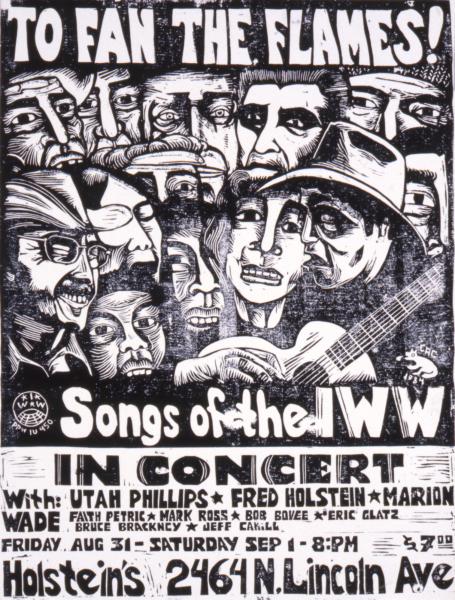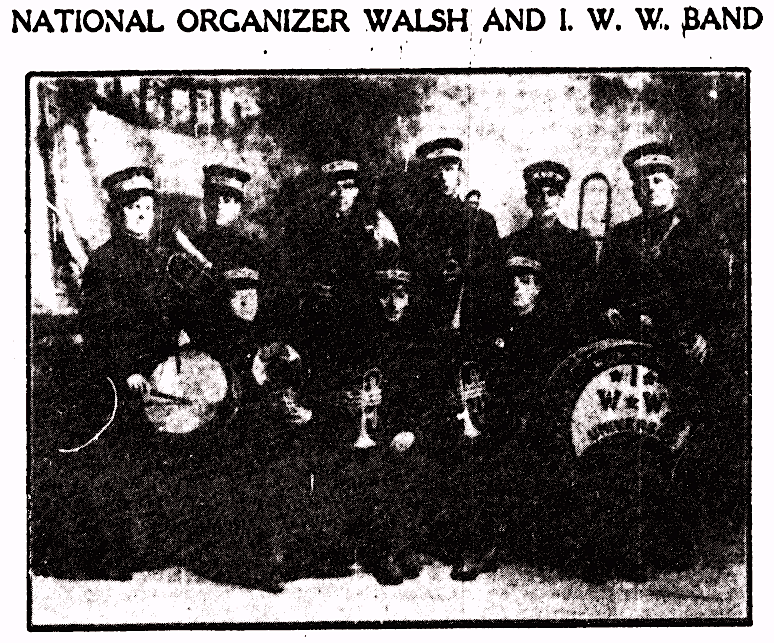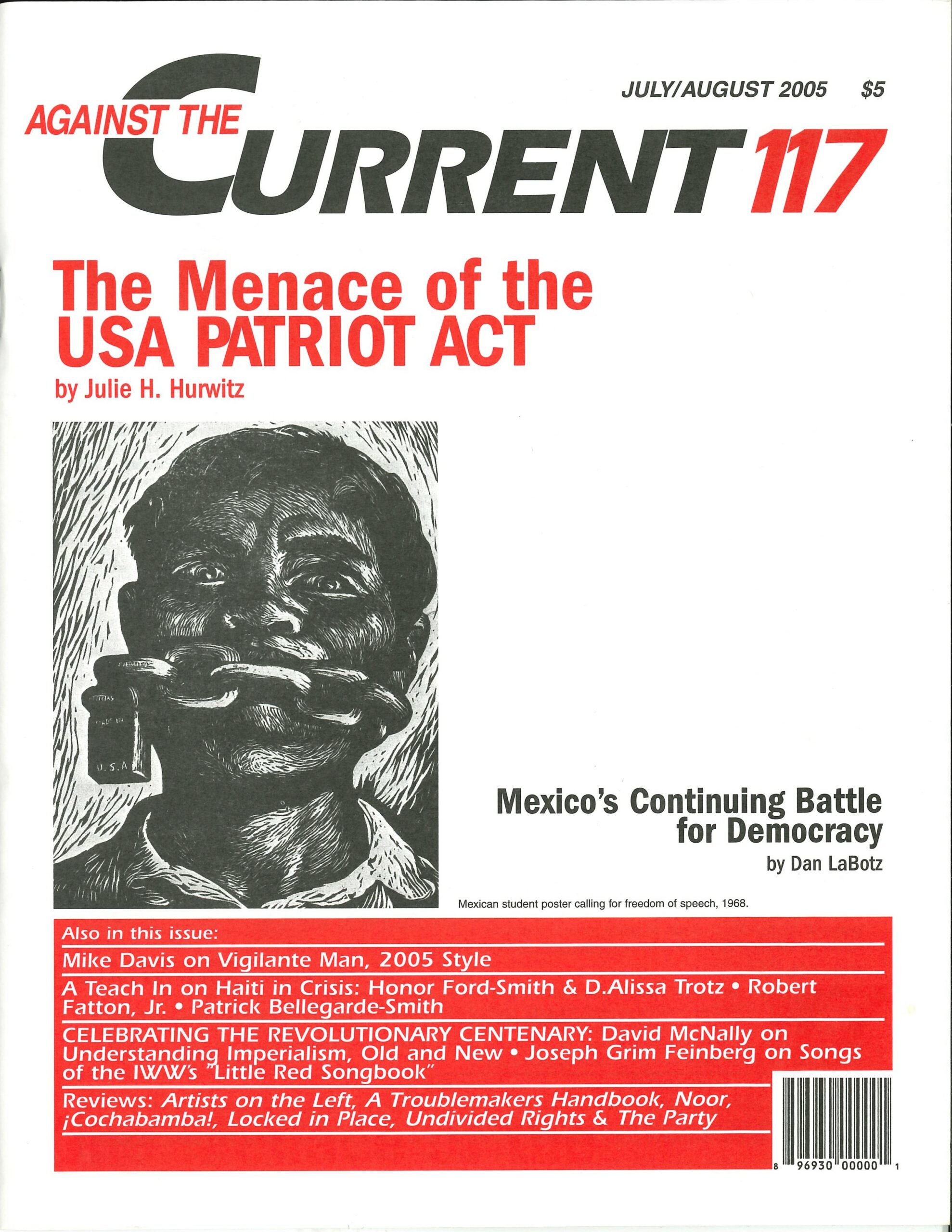Against the Current, No. 117, July/August 2005
-
Is This Sick or What?
— The Editors -
Vigilante Man, 2005 Style
— Mike Davis -
An Anti-Imperialist War Resister
— ATC Interviews Carl Webb -
Pension Terminations
— Malik Miah -
Scamming Social Security
— Susan Weissman interviews Michael Hudson -
The PATRIOT Act: Darkness With No Sunset
— Julie Hurwitz -
"Born into Brothels" Controversy
— Frann Michel -
Guatemala: The Violence of "Free Trade"
— Cyril Mychalejko -
Bolivia: The Fall of Carlos Mesa
— Jeffery R. Webber -
The Battle for Democracy in Mexico
— Dan La Botz - Haiti in Crisis
-
Haiti in Crisis
— Honor Ford-Smith and D. Alissa Trotz -
The Second Fall of Aristide
— Robert Fatton, Jr. -
Haiti: Racially Profiled!
— Patrick Bellegarde-Smith - Celebrating the Revolutionary Centenary
-
Understanding Imperialism: Old and New Dominion
— David McNally -
Gifts of the IWW
— Joseph Grim Feinberg - Reviews
-
Reading Red: Art & Social Revolution
— Alan Wald -
Water War in Bolivia
— Phil Hearse -
Noor: Casting Light on History
— Mahmud Rahman -
Studying State & Capitalist Development
— Raghu Krishnan -
Making Trouble Today
— Pam Galpern -
Women of Color & Reproductive Rights
— Dianne Feeley -
Recalling U.S. Trotskyism in the 1960s
— Paul Le Blanc
Joseph Grim Feinberg

I stood by a city prison,
In the twilight’s deepening gloom, Where men and women languished
In a loathsome, living tomb.
They were singing! And their voices
Seemed to weave a wreath of light,
As the words came clear with meaning:
“Workers of the World, unite!”
—From The Industrial Workers of the World,
written by Laura Payne Emerson,
sung to the tune of “The Wabash Cannonball”
IN JUNE OF this year, the Industrial Workers of the World celebrates 100 years of existence—a glorious and terrible 100 years. The IWW experienced the state-sponsored murder of its bravest members, most famously when “Wobbly Bard” Joe Hill was executed in 1915, having been framed for murder. It lived through years of slander and repression; limped along, still proud and singing, through decades when its membership dropped ever closer toward zero; and remains, not only as a piece of history, but as a force in the present and an inspiration for the future.
The IWW has been both a pioneering revolutionary organization in the history of North America, and one of the most aesthetic. As an “industrial union” that sought to organize all wage laborers into “one big union” (instead of many exclusive “craft unions”), the IWW attracted not only industrial workers but migrant laborers, hoboes and unemployed.
After its found in 1905, the union quickly grew, already rivaling other leading unions in strength by the early 1910s and reaching its peak membership in 1923-24 (Rosemont 2003: 14). It remained a powerful force until the 1930s in spite of the combined efforts of governments, bosses, other unions, and the Communist Party.
Suppression did take its toll, as did the changing structure of capitalism, with Fordist corporatism favoring more stable, class-cooperative, and conservative industrial organizations (although the current collapse of Fordism may produce conditions for a rebirth of the movement, or of something like it).
The Singing Union
The IWW, however, has left its deepest mark not on economic history, but on revolutionary culture. Its publications have been filled with cartoons ridiculing bosses, scabs and politicians. It has produced buttons, stickers, clothing, even bicycle lights with memorable IWW slogans and drawings.
Well known Wobbly (IWW) artist Carlos Cortez, who recently passed away, used his woodcuts to spread Wobbly ideas. Cortez was also a participant in the Chicago surrealist movement, several of whose painters, poets, and essayists have lent their talents to the Wobbly cause.

But more than anything else, the IWW is known for its songs. Early on it was called a “singing union,” and songs written by its members quickly spread throughout the North American working class and beyond. The union’s most famous means of disseminating its songs has been its Little Red Song Book, possibly the single most influential work of anticapitalist art in the English-speaking world.
Songs of the IWW have become classics, still sung by union members and radicals throughout North America. Full of wit, social theory and romantic dreams, they express the frustrations and pride of the workers, vagabonds and activists who wrote them and sing them. As the subtitle of the song book contends, the songs have “fan[ned] the flames of discontent” for generations.
The importance of the songs of the IWW is not only their ridicule of bosses and the work ethic, their praise of the struggles of the working class. Still more important is the social life that the songs have led. They arose in the course of struggles, written and sung by those involved. They circulated among the poorest of the North American poor.
They were sung in union halls, on picket lines, in the campfires of hobo “jungles.” Some songs stuck in the singers’ minds; others were forgotten. Some were published in the Little Red Song Book one year and then dropped from the book when the next edition appeared. Other songs remained in the book for decades, reflecting their continued life among the worker-singers themselves.
Dreams and Bitterness
Many songs spread far beyond the IWW itself, like Ralph Chaplin’s “Solidarity Forever,” often called the “hymn of the labor movement”; or “The Big Rock Candy Mountain” (attributed to Harry “Haywire Mac” McClintock), which conveys the utopian dreams of a hobo committed to the abolition of work; or Joe Hill’s “The Preacher and the Slave,” whose phrase “You’ll get pie in the sky when you die” expresses the bitterness of so many radicals toward reactionary preachers.

Joe Hill’s life and death also inspired many later songs, building on the tradition the IWW had begun. Most notable among these is Alfred Hayes’ “I Dreamed I Saw Joe Hill Last Night,” but also an almost-epic ballad by Phil Ochs called “Joe Hill.”
But relatively few people remember the authors of the classic IWW songs. And as years have gone by, the song lyrics have often changed, with words added or subtracted to fit changing times. Many listeners and singers may be aware of the songs’ Wobbly origins, but have little intention of returning to the “originals.”
Meanwhile, Wobbly singers and publishers have taken many songs of various origins and included them in their repertoire. This is as it should be: The songs of the IWW are folk songs in the best sense of the word. Newly created and recreated collectively by each generation of singers, they are active works of democratic, participatory art.
New Songs From Old
Though a handful of IWW songs have spread far and wide, some pearls of Wobbly wisdom have been under-recognized, while some have only recently been brought to popularity by the likes of folksinger Utah Philips. “Hallelujah, I’m a Bum,” whose earlier version was written by Harry McClintock, has been updated in recent years to include clever verses like these:
Oh, why do you work eight hours or more?
There’d be jobs ‘nough for two if you’d only work four.
Oh, why speed up work till you’re ready to fall?
If you’d only slow down, there’d be work for us all.
And while the IWW is known more for biting irony like this, Joe Hill’s “The White Slave”* shows a more poignant side of the union: One little girl, fair as a pearl, Worked every day in a laundry; All that she made, for food she paid, So she slept on a park bench so soundly An old procuress spied her there, She came and whispered in her ear: Come with me now, my girly, Don’t sleep out in the cold; Your face and tresses curly Will bring you fame and gold.
A Songster’s Testament
Joe Hill’s “Last Will” is another one of the more beautiful pieces written by an Industrial Worker of the World. Though this was not written as a song, it has become an important piece of Wobbly folklore, written as it was on the eve of the great songwriter’s execution, and repeated many times since by those who mourn Joe Hill’s loss (in spite of his injunction not to mourn for him, but to organize):
My will is easy to decide,
For there is nothing to divide.
My kin don’t need to fuss and moan –
“Moss does not cling to a rolling stone.”
My body? Ah, if I could choose,
I would to ashes it reduce,
And let the merry breezes blow
My dust to where some flowers grow.
Perhaps some fading flower then
Would come to life and bloom again.
This is my last and final will.
Good luck to all of you, JOE HILL.
But these songs filled industrial unionists’ hearts with inspiration not only because of their words, but because the words were theirs. Many IWW song lyrics might be disappointing to someone who simply reads them in a book; it’s different for people living in their midst. While singing together with fellow workers, Wobblies could feel that they play a role in the making of the songs; they could feel that the songs arose out of their own activity, and expressed the perspective of those around them.
It is one thing, a nice thing, to listen to a song; it is another to sing a song; and it is yet another thing to sing together with one’s comrades—just as it is one thing to be a free consumer, another to be a free individual, and yet another thing to act together freely, in struggle for the common good.

Without its songs (if we can imagine such a case), the IWW might still have been a powerful organization of the working class. But it is unlikely that it could have attracted as many members, that the members would have struggled with such confidence and passion, or that they would have enjoyed their lives as much as they did in the midst of material misery.
A Mass Aesthetic
The IWW was not the first or last revolutionary movement to make art into a part of its struggle. But no other group has done it quite the same way. The avant-garde artists of interwar Europe were socialists more often than not, but rarely successful in attracting the masses to their aesthetic projects. Proletkult in revolutionary Russia directly involved hundreds of thousands of workers and peasants, but its art never became an enduring part of folk culture, probably due in part to its adoption of an avant-garde aesthetic.
Many romantics, realists and naturalists of earlier decades were revolutionaries, but their first devotion was to fine art and high literature, not the participatory creation of culture. The muralists of revolutionary Mexico and the New Deal reached the masses with their art, but they did not involve the masses directly.
This is not to deny that these revolutions produced folk art. In every epoch and in every revolution, people have made their own art. They have sung about their lives, about their hardships and their hopes. There are songs of the “American” and Mexican Revolutions, of the Spanish “Civil War,” of the Civil Rights Movement in the United States. There are the songs of the labor movement in the United States, not only those from the Industrial Workers of the World. And in the 1960s, revolutionary folk songs sprang up around the world, sometimes spreading among workers and poor, and in most cases spreading through masses of students and youth.
In the 1980s, hip hop grew out of the oppression of the African-American ghetto, and soon spread through poor neighborhoods in the rest of the world—sometimes democratically, and sometimes in commercialized form. Meanwhile punk rock, with a healthy disposition toward “do-it- yourself” culture, bubbled up from the cauldron of white lower-class disgust with the world as it was and remains.
Yet the IWW has contributed uniquely, relative to the size of its membership, to the songs of workers’ struggles in the United States. And its songs stand out for their steadfast radicalism and for their ironic and vivid style. No other union created a culture so encouraging to radical songwriting; and none so actively encouraged such songs to be circulated and sung—songs that in the 1910s and ’20s helped bring the United States closer to workers’ revolution than it has ever come.
The Little Red Song Book stands out, in my view, as a masterpiece of world literature. More importantly, the songs stand out as masterworks of collective, participatory, revolutionary culture. But the term “masterworks” only serves to place them on par with other, less participatory works of art. The songs of the IWW are not great because they sit published in a book, already made. Like any folk songs, they remain great only as long as they are sung. May the IWW live another 100 years, and its songs live on forever—but recreated, always changing, with each new voice that sings.
So let’s sing. At least a little bit more than we have been doing lately.
*Editor’s Note: A now-antiquated term for prostitution, “white slavery” particularly references the recruitment and trafficking of women trapped in poverty. The racial as well as sexist connotations of the term are obvious, identifying the purity of “whiteness” with the presumed innocence of women. In today’s global corporate economy, trafficking of women from the “Global South” has become even more widespread for the international as well as domestic sex industry.
Musical Gifts of the IWW:
Further Reading and Singing
Kornbluh, Joyce L., ed. Rebel Voices: An IWW Anthology. Introduction by Fred Thompson. Chicago: Charles H. Kerr, 1998. 419 pages.
Rosement, Franklin. Joe Hill: The IWW and the Making of a Revolutionary Working-Class Counterculture. Chicago: Charles H. Kerr, 2003. 656 pages.
The IWW Little Red Songbook, 19th Edition, 1923 (reprint). Chicago: Charles H. Kerr, 1989. 64 pages.
A “Centennial Edition” of The Little Red Songbook is expected to be published shortly and should be available through the Industrial Workers of the World (www.iww.org). Books by the Charles H. Kerr publishing company can ordered online at www.iww.org/store/books/kerr. Recordings of IWW songs can be ordered online at www.iww.org/store/discs
Joseph Grim Feinberg studies folklore and social movements as a graduate student at the University of Chicago. He is a member of Solidarity.
ATC 117, July-August 2005

